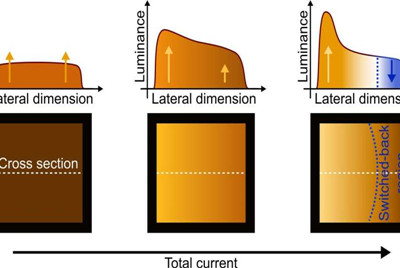
It is well-known that LEDs and transistors should not be connected in parallel as slight differences in resistance can lead to imbalanced current flow. This effect gets even stronger if the devices heat up as their resistance changes with temperature. For organic LEDs (OLEDs), this is a big issue: Every large-area OLED lighting panel can be understood as a parallel connection of numerous individual tiny OLEDs. As a consequence, these devices show inhomogeneous light emission if they heat up. A phenomenon that has been observed by researchers as well as industrial companies in the last couple of years, is a saturation of brightness that occurs even though the total applied current is continuously increased.
Now a team of researchers from TU Dresden and the Weierstrass Institute Berlin experimentally prove that OLEDs do not only saturate, they even show regions that are switched-back in brightness: Suddenly the OLED gets darker in a certain area although the total applied current is increased—clearly a counter-intuitive result. This so-called "switched-back" effect is directly related to the presence of a strong nonlinear electrothermal feedback in OLEDs that takes place upon heating up and which in turn induces negative differential resistance that makes the device prone to unstable operation.
The results have a strong impact on understanding long-term stability in applications with high brightness e.g. as they are found in the automotive sector. Here, OLEDs are now under consideration to replace LED technology for tail lights, signal lights, and brake lights due to their new design possibilities. One problem OLEDs are still facing is sudden-death phenomena. They are rarely described in literature due to their unpredictable and seemingly random occurrence. However, it is likely that the now proven switched-back regions are strongly related to such sudden-death phenomena. A better understanding of the OLED as a complex electrothermal system will, therefore, be essential to forecast device breakdown and to develop new strategies for better brightness uniformity and device stability. In the future, novel applications with ultra-high light intensity such as organic lasers will also benefit from exact knowledge about self-heating effects.
The cooperation between the two groups dates back to 2011. Since then, several joint publications about electrothermal feedback in organic semiconductor devices have been published. "The prediction of the switched-back regions actually goes back to 2014 when we got some initial hints by a rather rudimentary simulation," said Dr. Axel Fischer who is the corresponding author of this work, and who continues, "we then focused on creating an improved setup that would allow us to measure the effect for our lab-scale samples."
The term "switched-back" is actually related to the current density that locally decreases in the OLED in contrast to the total current that still increases. As it is difficult to measure the local current density, a camera was used to detect the emission that corresponds to the local current flow. If there would be a decreasing brightness before the OLED degrades, it would be proof of switched-back regions. Indeed, the experimentalists suddenly observed a decreasing luminance in the expected region of the active area just after the first negative differential resistance occurred.
These experiments have been carried out and evaluated by Anton Kirch, who is currently a Ph.D. student at TU Dresden. "First, a region of negative differential resistance occurs and propagates through the device for increasing the supply current. At a certain point, they switch back regions that are distant to the electrodes and which do not have a sufficiently high power dissipation. One can imagine that these switched-back regions only 'see' the decreasing voltage of the OLED parts operating in the regime of negative differential resistance and do not know that the externally applied voltage still increases."
To confirm the experimental results, the complex interplay between current and heat flow was studied numerically in a highly nonlinear system, taking the different layers of the OLED into account. Therefore, the mathematicians from the Weierstrass Institute Berlin created a simulation tool for solving the derived system of partial differential equations. "We had to introduce an advanced path following algorithm," explains Dr. Matthias Liero, "to capture the behavior of the device within the bistable regime, i.e. when parts of the OLED operate in the regime of negative differential resistance."
After this was implemented, the numerical simulation was able to reproduce the experimental finding based on reasonable assumptions and parameters. Liero further outlines: "Frankly, we have been astonished about the qualitative and the quantitative agreement between simulation and experiment. The shape and occurrence of the switched-back region were calculated as found in the experiment." The group is now looking for further partners from science as well as from industry to transfer the results from lab-scale OLEDs to larger thin-film lighting panels and more complicated geometries.
Both groups want to continue their joint work on electrothermal feedback. The next challenges are to create new strategies to prevent switched-back regions in order to homogenize the luminance even upon self-heating. It will be the aim to create non-trivial solutions that explicitly take the non-linear nature of the problem into account. Furthermore, in-depth studies exploring the interdependency between the appearance of switched-back regions and sudden-death scenarios have been started.

